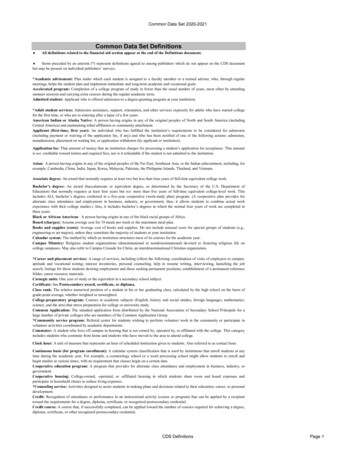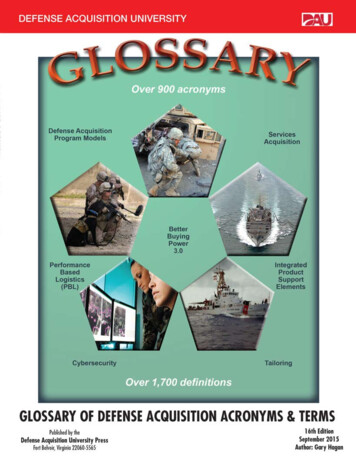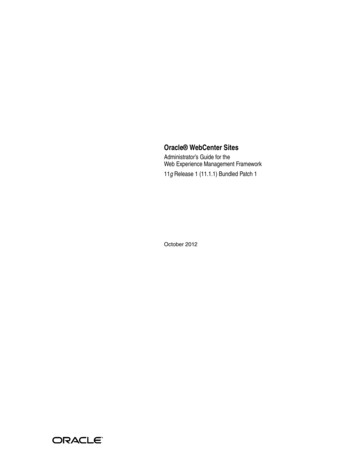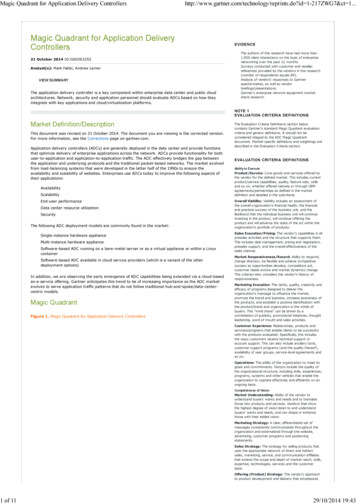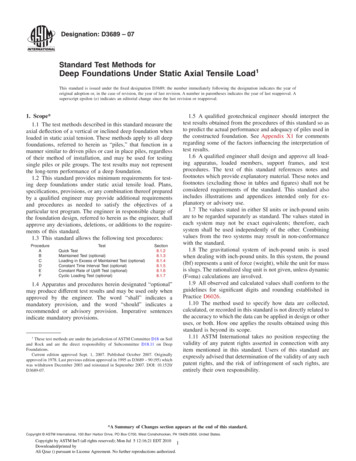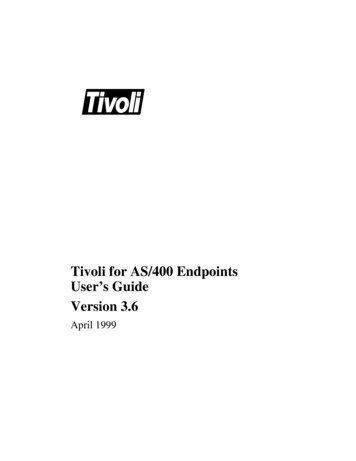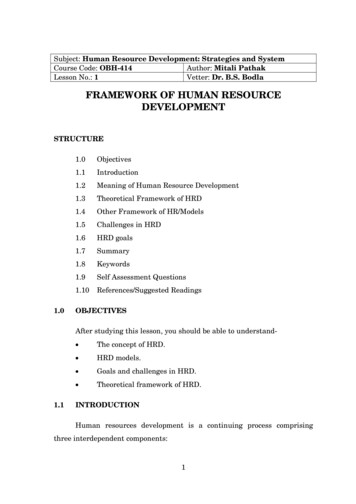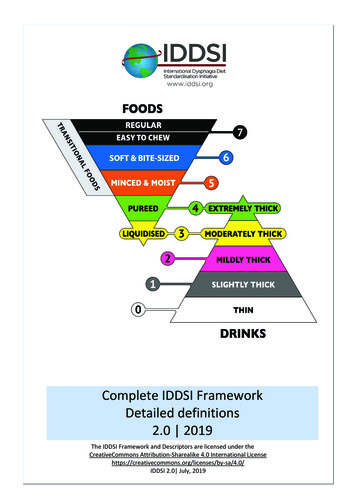
Transcription
Complete IDDSI FrameworkDetailed definitions2.0 2019The IDDSI Framework and Descriptors are licensed under theCreativeCommons Attribution-Sharealike 4.0 International 4.0/IDDSI 2.0 July, 2019
INTRODUCTIONThe International Dysphagia Diet Standardisation Initiative (IDDSI) was founded in 2013 with the goal ofdeveloping new international standardised terminology and definitions to describe texture modified foods andthickened liquids used for individuals with dysphagia of all ages, in all care settings, and all cultures.Three years of work by the International Dysphagia Diet Standardisation Committee culminated in the 2016release and 2017 publication of the IDDSI Framework consisting of a continuum of 8 levels (0-7). Levels areidentified by numbers, text labels and colour codes. [Reference: Cichero JAY, Lam P, Steele CM, Hanson B, Chen J,Dantas RO, Duivestein J, Kayashita J, Lecko C, Murray J, Pillay M, Riquelme L, Stanschus S. (2017) Development ofinternational terminology and definitions for texture-modified foods and thickened fluids used in dysphagiamanagement: The IDDSI Framework. Dysphagia, 32:293-314. 6-9758-y]The Complete IDDSI Framework Detailed Definitions 2019 is an update to the 2016 document. The CompleteIDDSI Framework Detailed Definitions document provides detailed descriptors for all levels of the IDDSIFramework. Descriptors are supported by simple measurement methods that can be used by people withdysphagia or by caregivers, clinicians, food service professionals or industry to confirm the level a food or drinkfits into.This document is to be read in conjunction with IDDSI Testing Methods 2019, IDDSI Evidence 2016 and IDDSIFrequently Asked Questions (FAQs) documents ( https://iddsi.org/framework/).The IDDSI Framework provides a common terminology to describe food textures and drink thickness. IDDSI testsare intended to confirm the flow or textural characteristics of a particular product at the time of testing. Testingshould be done on foods and drinks under the intended serving conditions (especially temperature). The clinicianhas the responsibility to make recommendations for foods or drinks for a particular patient based on theircomprehensive clinical assessment.IDDSI would like to acknowledge the interest and participation of the global community including patients,caregivers, health professionals, industry, professional associations and researchers. We would also like to thankour sponsors for their generous support.Please visit https://iddsi.org/ for further information.The IDDSI Board:The IDDSI Board are a group of volunteers who do not draw a salary from IDDSI. They offer their knowledge,expertise and time for the benefit of the international community.Co-Chairs: Peter Lam (CAN) & Julie Cichero (AUS);Board Members: Jianshe Chen (CHN), Roberto Dantas (BRA), Janice Duivestein (CAN), Ben Hanson (UK),Jun Kayashita (JPN), Mershen Pillay (ZAF), Luis Riquelme (USA), Catriona Steele (CAN),Jan Vanderwegen (BE).Past Board Members: Joseph Murray (USA), Caroline Lecko (UK), Soenke Stanschus (GER)The International Dysphagia Diet Standardisation Initiative Inc. (IDDSI) is independent and operates as a not-forprofit entity. IDDSI is grateful to a large number of agencies, organizations and industry partners for financial andother support. Sponsors have not been involved with the design or development of the IDDSI framework.Implementation of the IDDSI framework is in progress. IDDSI is extremely grateful to all sponsors supportingimplementation https://iddsi.org/about-us/sponsors/The IDDSI Framework and Descriptors are licensed under theCreativeCommons Attribution-Sharealike 4.0 International 4.0/IDDSI 2.0 July, 20192
Description/Characteristics Flows like waterFast flowCan drink through any type of teat/nipple, cup or straw asappropriate for age and skillsPhysiological rationale for thislevel of thickness Functional ability to safely manage liquids of all typesAlthough descriptions are provided, use IDDSI Testing methods to decide if the liquid meets IDDSI Level 0.TESTING METHODSee also IDDSI Testing Methods document or IDDSI Flow Test*#Before Less than 1 mL remaining in the 10 mL slip tip syringe# after 10 secondsof flow (see IDDSI Flow Test instructions*)you test.You must check yoursyringe lengthbecause there aredifferences in syringelengths. Your syringeshould look like thisIDDSI FLOW TEST INSTRUCTIONSThe IDDSI Framework and Descriptors are licensed under theCreativeCommons Attribution-Sharealike 4.0 International 4.0/IDDSI 2.0 July, 20193
Description/Characteristics Thicker than waterRequires a little more effort to drink than thin liquidsFlows through a straw, syringe, teat/nippleSimilar to the thickness of most commercially available‘Anti-regurgitation’ (AR) infant formulasPhysiological rationale for thislevel of thickness Often used in the paediatric population as a thickened drink thatreduces speed of flow yet is still able to flow through an infantteat/nipple. Consideration to flow through a teat/nipple should bedetermined on a case-by-case basis.Also used in adult populations where thin drinks flow too fast to becontrolled safely. These slightly thick liquids will flow at a slightlyslower rate. Although descriptions are provided, use IDDSI Testing methods to decide if the liquid meets IDDSI Level 1.TESTING METHODSee also IDDSI Testing Methods document or https://iddsi.org/framework/drink-testing-methods/ IDDSI Flow Test*#BeforeTest liquid flows through a 10 mL slip tip syringe# leaving 1-4 mL in thesyringe after 10 seconds (see IDDSI Flow Test instructions*)you test.You must check yoursyringe lengthbecause there aredifferences in syringelengths. Your syringeshould look like thisIDDSI FLOW TEST INSTRUCTIONSThe IDDSI Framework and Descriptors are licensed under theCreativeCommons Attribution-Sharealike 4.0 International 4.0/IDDSI 2.0 July, 20194
Description/Characteristics Flows off a spoonSippable, pours quickly from a spoon, but slower than thin drinksMild effort is required to drink this thickness through standard borestraw (standard bore straw 0.209 inch or 5.3 mm diameter)Physiological rationale for thislevel of thickness If thin drinks flow too fast to be controlled safely, these Mildly Thickliquids will flow at a slightly slower rate May be suitable if tongue control is slightly reduced.Although descriptions are provided, use IDDSI Testing methods to decide if the liquid meets IDDSI Level 2.TESTING METHODSee also IDDSI Testing Methods document or https://iddsi.org/framework/drink-testing-methods/ IDDSI Flow Test*#BeforeTest liquid flows through a 10 mL slip tip syringe leaving 4 to 8 ml inthe syringe after 10 seconds (see IDDSI Flow Test instructions*)you test.You must check yoursyringe lengthbecause there aredifferences in syringelengths. Your syringeshould look like thisIDDSI FLOW TEST INSTRUCTIONSThe IDDSI Framework and Descriptors are licensed under theCreativeCommons Attribution-Sharealike 4.0 International 4.0/IDDSI 2.0 July, 20195
Description/characteristics Physiological rationale for thislevel of thickness Can be drunk from a cupModerate effort is required to suck through a standard bore or widebore straw (wide bore straw 0.275 inch or 6.9 mm)Cannot be piped, layered or molded on a plate because it will notretain its shapeCannot be eaten with a fork because it drips slowly in dollopsthrough the prongsCan be eaten with a spoonNo oral processing or chewing required – can be swallowed directlySmooth texture with no ‘bits’ (lumps, fibers, bits of shell or skin,husk, particles of gristle or bone)If tongue control is insufficient to manage Mildly Thick drinks (Level 2),this Liquidised/Moderately thick level may be suitableAllows more time for oral controlNeeds some tongue propulsion effortPain on swallowingAlthough descriptions are provided, use IDDSI Testing methods to decide if the food/liquid meets IDDSI Level 3.TESTING METHODSSee also IDDSI Testing Methods document or https://iddsi.org/framework/drink-testing-methods/ s/IDDSI Flow Test* Test liquid flows through a 10 ml slip tip syringe leaving 8 ml in thesyringe after 10 seconds (see IDDSI Flow Test Guide*)Fork Drip Test Drips slowly in dollops through the prongs of a forkWhen a fork is pressed on the surface of Level 3 Moderately ThickLiquid/Liquidised food, the tines/prongs of a fork do not leave a clearpattern on the surfaceSpreads out if spilled onto a flat surfaceEasily pours from spoon when tilted; does not stick to spoonWhere forks are not availableChopstick TestWhere forks are not availableFinger Test Chopsticks are not suitable for this texture It is not possible to hold a sample of this food texture using fingers,however, this texture slides smoothly and easily between the thumband fingers, leaving a coatingFood specific orOther examples(NB. this list is not exhaustive)The following items may fit into IDDSI Level 3: Infant “first foods” (runny rice cereal or runny pureed fruit) Some sauces and gravies, as confirmed by IDDSI Flow TestSpoon Tilt TestThe IDDSI Framework and Descriptors are licensed under theCreativeCommons Attribution-Sharealike 4.0 International 4.0/IDDSI 2.0 July, 20196
#BeforeSome syrups, as confirmed by IDDSI Flow Testyou test.You must check yoursyringe lengthbecause there aredifferences in syringelengths. Your syringeshould look like thisIDDSI FLOW TEST INSTRUCTIONSDrips slowly or in dollops/strandsthrough the slots of a forkThe IDDSI Framework and Descriptors are licensed under theCreativeCommons Attribution-Sharealike 4.0 International 4.0/IDDSI 2.0 July, 20197
Description/characteristics Physiological rationale for this levelof thickness Usually eaten with a spoon (a fork is possible)Cannot be drunk from a cup because it does not flow easilyCannot be sucked through a strawDoes not require chewingCan be piped, layered or molded because it retains its shape, butshould not require chewing if presented in this formShows some very slow movement under gravity but cannot bepouredFalls off spoon in a single spoonful when tilted and continues tohold shape on a plateNo lumpsNot stickyLiquid must not separate from solidIf tongue control is significantly reduced, this category may be easiestto controlRequires less propulsion effort than Minced & Moist (level 5), Soft &Bite-Sized (Level 6) and Regular and Regular Easy to Chew (Level 7)but more than Liquidised/Moderately thick (Level 3)No biting or chewing is requiredIncreased oral and/or pharyngeal residue is a risk if too stickyAny food that requires chewing, controlled manipulation or bolusformation are not suitablePain on chewing or swallowingMissing teeth, poorly fitting denturesAlthough descriptions are provided, use IDDSI Testing methods to decide if the food/liquid meets IDDSI Level 4.TESTING METHODSSee also IDDSI Testing Methods document or DDSI Flow test n/a. The IDDSI Flow test is not applicable, please use the Fork DripTest and Spoon Tilt TestFork Pressure test Fork Drip testFork Drip test contd. Smooth with no lumps and minimal granulationWhen a fork is pressed on the surface of Level 4 Extremely ThickLiquid/Pureed food, the tines/prongs of a fork can make a clearpattern on the surface, and/or the food retains the indentation fromthe forkSample sits in a mound/pile above the fork; a small amount may flowthrough and form a short tail below the fork tines/prongs, but it doesnot flow or drip continuously through the prongs of a fork (seeThe IDDSI Framework and Descriptors are licensed under theCreativeCommons Attribution-Sharealike 4.0 International 4.0/IDDSI 2.0 July, 20198
picture below)Spoon Tilt test Cohesive enough to hold its shape on the spoonA full spoonful must plop off the spoon if the spoon is titled or turnedsideways; a very gentle flick (using only fingers and wrist) may benecessary to dislodge the sample from the spoon, but the sampleshould slide off easily with very little food left on the spoon. A thinfilm remaining on the spoon after the Spoon Tilt Test is acceptable,however, you should still be able to see the spoon through the thinfilm; i.e. the sample should not be firm and stickyMay spread out slightly or slump very slowly on a flat plateWhere forks are not availableChopstick test Chopsticks are not suitable for this textureWhere forks are not availableFinger test It is just possible to hold a sample of this texture using fingers. Thetexture slides smoothly and easily between the fingers and leavesnoticeable coatingIndicators that a sample is too thick Does not fall off the spoon when tiltedSticks to spoon FOOD SPECIFIC OR OTHER EXAMPLESThe following item may be suitable for IDDSI Level 4: Purees suitable for infants (e.g. pureed meat, thick cereal)Sits in a mound orpile above the forkA small amount may flow through and form a short tail below the forkDoes not dollop, flow or drip continuously through the fork prongsSpoon Tilt Test: Holds shape on spoon; not firm and sticky; little food left on spoonThe IDDSI Framework and Descriptors are licensed under theCreativeCommons Attribution-Sharealike 4.0 International 4.0/IDDSI 2.0 July, 20199
The following images show examples of foods that would be suitable or unsuitable forLevel 4 according to the IDDSI Spoon Tilt TestSpoon Tilt Test: SAFE: Holds shape on spoon; not firm and sticky; little food left on spoonþþþSpoon Tilt Test: SAFE: Holds shape on spoon; not firm and sticky; little food left on spoonþþþSpoon Tilt Test: UNSAFE:Holds shape on spoon; FIRM AND STICKY; LOTS OF food left on spoon The IDDSI Framework and Descriptors are licensed under theCreativeCommons Attribution-Sharealike 4.0 International 4.0/IDDSI 2.0 July, 201910
Description/characteristics Physiological rationale for this levelof thickness Can be eaten with a fork or spoonCould be eaten with chopsticks in some cases, if the individual hasvery good hand controlCan be scooped and shaped (e.g. into a ball shape) on a plateSoft and moist with no separate thin liquidSmall lumps visible within the foodØ Paediatric, equal to or less than 2 mm width and no longer than8mm in lengthØ Adult, equal to or less than 4mm width and no longer than15mm in lengthLumps are easy to squash with tongueBiting is not requiredMinimal chewing is requiredTongue force alone can be used to separate the soft small particles inthis textureTongue force is required to move the bolusPain or fatigue on chewingMissing teeth, poorly fitting denturesAlthough descriptions are provided, use IDDSI Testing methods to decide if the food meets IDDSI Level 5.TESTING METHODSSee also IDDSI Testing Methods document or ork Pressure test When pressed with a fork the particles should easily be separatedbetween and come through the tines/prongs of a forkCan be easily mashed with little pressure from a fork [pressureshould not make the thumb nail blanch to white]Fork Drip test When a sample is scooped with a fork it sits in a pile or can mound onthe fork and does not easily or completely flow or fall through thetines/prongs of a forkSpoon Tilt test Cohesive enough to hold its shape on the spoonA full spoonful must slide/pour off/fall off the spoon if the spoon istilted or turned sideways or shaken lightly; the sample should slideoff easily with very little food left on the spoon; i.e. the sampleshould not be stickyA scooped mound may spread or slump very slightly on a plate Where forks are not availableChopstick test Chopsticks can be used to scoop or hold this texture if the sample ismoist and cohesive and the person has very good hand control to usechopsticksThe IDDSI Framework and Descriptors are licensed under theCreativeCommons Attribution-Sharealike 4.0 International 4.0/IDDSI 2.0 July, 201911
Where forks are not availableFinger test It is possible to easily hold a sample of this texture using fingers;small, soft, smooth, rounded particles can be easily separated usingfingers. The material will feel moist and leave fingers wet.FOOD SPECIFIC OR OTHER EXAMPLES EAT Finely minced* or chopped*, soft minceo Paediatric, equal to or less than 2mm widthand no longer than 8mm in lengtho Adult, equal to or less than 4mm width and nomore than 15mm in length Serve in mildly, moderately or extremely thick,smooth, sauce or gravy, draining excess *If texture cannot be finely minced it should be pureedFISH Finely mashed in mildly, moderately or extremely thicksmooth, sauce or gravy, draining excesso Paediatric, equal to or less than 2mm widthand no longer than 8mm in lengtho Adult, equal to or less than 4mm width and nomore than 15mm in lengthFRUIT Serve finely minced or chopped or mashed Drain excess juice If needed, serve in mildly, moderately or extremelythick smooth sauce or gravy AND drain excess liquid.No thin liquid should separate from foodo Paediatric, equal to or less than 2mm width andno longer than 8mm in lengtho Adult, equal to or less than 4mm width and nomore than 15mm in lengthUse slot between fork prongs (4mm) todetermine whether minced pieces are thecorrect or incorrect sizeTRNote - lump size requirements for allfoods in Level 5 Minced & Moist:Ø Paediatric, equal to or less than2mm width and no more than8mm in lengthØ Adult, equal to or less than 4mmwidth and no more than 15mmin lengthVEGETABLES Serve finely minced or chopped or mashed Drain any liquid If needed, serve in mildly, moderately or extremely thicksmooth sauce or gravy AND drain excess liquid. No thinliquid should separate from foodo Paediatric, equal to or less than 2mm width and no longer than 8mm in lengtho Adult, equal to or less than 4mm width and no more than 15mm in lengthCEREAL Thick and smooth with small soft lumpso Paediatric, equal to or less than 2mm width and no longer than 8mm in lengtho Adult, equal to or less than 4mm width and no more than 15mm in length Texture fully softened Any milk/fluid must not separate away from cereal. Drain any excess fluid before servingThe IDDSI Framework and Descriptors are licensed under theCreativeCommons Attribution-Sharealike 4.0 International 4.0/IDDSI 2.0 July, 201912
BREAD No regular, dry bread, sandwiches or toast of any kind Use IDDSI Level 5 Minced & Moist sandwich recipe videohttps://www.youtube.com/watch?v W7bOufqmz18 Pre-gelled ‘soaked’ breads that are very moist and gelledthrough the entire thicknessRICE, COUSCOUS, QUINOA (and similar food textures) Not sticky or glutinous Should not be particulate or separate into individual grains when cooked and served Serve with smooth mildly, moderately or extremely thick sauce AND Sauce must not separate away from rice,couscous, quinoa (and similar food textures). Drain excess fluid before servingMinced & Moist food mustpass all three tests!IDDSI Fork TestPaediatric, equal to or less than2mm width and no more than8mm in lengthSoft enough tosquash easily withfork or spoonAdult, equal to or less than4mm width and no more than15mm in lengthDon’t need thumbnail to blanchwhiteIDDSI Spoon Tilt TestSample holds its shape onthe spoon and falls offfairly easily if the spoon istilted or lightly flickedSample should not be firmor sticky4mm is about the gap betweenthe prongs of a standard dinnerforkThe IDDSI Framework and Descriptors are licensed under theCreativeCommons Attribution-Sharealike 4.0 International 4.0/IDDSI 2.0 July, 201913
Description/characteristics Physiological rationale for this levelof thickness Can be eaten with a fork, spoon or chopsticksCan be mashed/broken down with pressure from fork, spoon orchopsticksA knife is not required to cut this food, but may be used to helpload a fork or spoonSoft, tender and moist throughout but with no separate thin liquidChewing is required before swallowing‘Bite-sized’ pieces as appropriate for size and oral processing skillsØ Paediatric, 8mm pieces (no larger than)Ø Adults, 15 mm 1.5 cm pieces (no larger than)Biting is not requiredChewing is requiredFood piece sizes designed to minimize choking riskTongue force and control is required to move the food and keep itwithin the mouth for chewing and oral processingTongue force is required to move the bolus for swallowingPain or fatigue on chewingMissing teeth, poorly fitting denturesAlthough descriptions are provided, use IDDSI Testing methods to decide if the food meets IDDSI Level 6.TESTING METHODSSee also IDDSI Testing Methods document or ork Pressure test Spoon Pressure test Where forks are not availableChopstick test Pressure from a fork held on its side can be used to ‘cut’ or breakapart or flake this texture into smaller piecesWhen a sample the size of a thumb nail (1.5x1.5 cm) is pressed withthe tines of a fork to a pressure where the thumb nail blanches towhite, the sample squashes, breaks apart, changes shape, and doesnot return to its original shape when the fork is removed.Pressure from a spoon held on its side can be used to ‘cut’ or breakthis texture into smaller pieces.When a sample the size of a thumb nail (1.5 cm x1.5 cm) is pressedwith the base of a spoon, the sample squashes, breaks apart,changes shape, and does not return to its original shape when thespoon is removed.Chopsticks can be used to break this texture into smaller pieces orpuncture foodThe IDDSI Framework and Descriptors are licensed under theCreativeCommons Attribution-Sharealike 4.0 International 4.0/IDDSI 2.0 July, 201914
Where forks are not availableFinger test Use a sample the size of a thumb nail (1.5 cm x 1.5 cm). It ispossible to squash a sample of this texture using finger pressuresuch that the thumb and index finger nails blanch to white. Thesample breaks apart and will not return to its initial shape oncepressure is released.FOOD SPECIFIC OR OTHER EXAMPLESMEAT Cooked, tender meat no bigger than Paediatric, 8mm pieces Adults, 15 mm 1.5 x 1.5 cm pieces If texture cannot be served soft and tender at 1.5cm x 1.5 cm (as confirmed with fork/ spoonpressure test), serve minced and moistNote - food size requirements for allfoods in Level 6 Soft & Bite-sized:Ø Paediatric, 8mm piecesØ Adult, 15mm 1.5cm piecesFISH Soft enough cooked fish to break into small pieces with fork, spoon or chopsticks no larger than Paediatric, 8mm pieces Adults, 15 mm 1.5 cm pieces No bones or tough skinsCASSEROLE/STEW/CURRY Liquid portion (e.g. sauce) must be thick (as per clinician recommendations) Can contain meat, fish or vegetables if final cooked pieces are soft and tender and no larger than Paediatric, 8mm pieces Adults, 15 mm 1.5 cm pieces No hard lumpsFRUIT Serve minced or mashed if cannot be cut to soft & bite-sized pieces Paediatric, 8mm pieces Adults, 15 mm 1.5 cm pieces Fibrous parts of fruit are not suitable Drain excess juice Assess individual ability to manage fruit with high water content (e.g. watermelon) where juice separatesfrom solid in the mouth during chewingVEGETABLES Steamed or boiled vegetables with final cooked size of Paediatric, 8mm pieces Adults, 15 mm 1.5 cm pieces Stir fried vegetables may be too firm and are not soft or tender. Check softness with fork/spoon pressuretestCEREAL Smooth with soft tender lumps no bigger than Paediatric, 8mm pieces Adults, 15 mm 1.5 cm pieces Texture fully softened Any excess milk or liquid must be drained and/or thickened to thickness level recommended by clinicianThe IDDSI Framework and Descriptors are licensed under the15CreativeCommons Attribution-Sharealike 4.0 International 4.0/IDDSI 2.0 July, 2019
BREAD No regular dry bread, sandwiches or toast of any kind Use IDDSI Level 5 Minced & Moist sandwich recipe video toprepare bread and add to filling that meets Level 6 Soft & Bitesized requirementshttps://www.youtube.com/watch?v W7bOufqmz18 Pre-gelled ‘soaked’ breads that are very moist and gelled throughthe entire thicknessRICE, COUCOUS, QUINOA (and similar food textures) Not particulate/grainy, sticky or glutinousThumb nail blanchedto whiteFood pieces nobigger than 8mm x8mm lump size forchildrenFood pieces no bigger than1.5cm x 1.5cm bite sizefor adultsSample squashes and does not returnto its original shape when pressure isreleasedSoft & Bite-Sized foodmust pass bothfood piece size andsoftness tests!The IDDSI Framework and Descriptors are licensed under theCreativeCommons Attribution-Sharealike 4.0 International 4.0/IDDSI 2.0 July, 201916
Description/characteristics Physiological rationale for thislevel of thickness Normal, everyday foods of soft/tender textures that aredevelopmentally and age appropriateAny method may be used to eat these foodsSample size is not restricted at Level 7, therefore, foods may be of arange of sizesØ Smaller or greater than 8mm pieces (Paediatric)Ø Smaller or greater than 15 mm 1.5 cm pieces (Adults)Does not include: hard, tough, chewy, fibrous, stringy, crunchy, orcrumbly bits, pips, seeds, fibrous parts of fruit, husks or bonesMay include ‘dual consistency’ or ‘mixed consistency’ foods and liquidsif also safe for Level 0, and at clinician discretion. If unsafe for Level 0Thin, liquid portion can be thickened to clinician’s recommendedthickness levelRequires the ability to bite soft foods and chew and orally process foodfor long enough that the person forms a soft cohesive ball/bolus that is‘swallow ready’. Does not necessarily require teeth.Requires the ability to chew and orally process soft/tender foodswithout tiring easilyMay be suitable for people who find hard and/or chewy foods difficultor painful to chew and swallowThis level could present a choking risk for people with clinicallyidentified increased risk of choking, because food pieces can be of anysize. Restricting food piece sizes aims to minimize choking risk (e.g.Level 4 Pureed, Level 5 Minced & Moist, Level 6 Soft & Bite-sized havefood piece size restrictions to minimize choking risk)This level may be used by qualified clinicians for developmentalteaching, or progression to foods that need more advanced chewingskillsIf the person needs supervision to eat safely, before using thistexture level consult a qualified clinician to determine the person’sfood texture needs, and meal time plan for safety People can be unsafe to eat without supervision due tochewing and swallowing problems and/or unsafe mealtimebehaviours. Examples of unsafe mealtime behaviors include:not chewing very well, putting too much food into the mouth,eating too fast or swallowing large mouthfuls of food, inabilityto self-monitor chewing ability. Clinicians should be consulted for specific advice for patientneeds, requests and requirements for supervision. Where mealtime supervision is needed, this level should onlybe used under the strict recommendation and writtenguidance of a qualified clinicianThe IDDSI Framework and Descriptors are licensed under theCreativeCommons Attribution-Sharealike 4.0 International 4.0/IDDSI 2.0 July, 201917
Although descriptions are provided, use IDDSI Testing methods to decide if the food meets IDDSI Level 7 Easy toChew.TESTING METHODSSee also IDDSI Testing Methods document or https://iddsi.org/framework/food-testing-methods/ Fork Pressure Test Spoon Pressure Test Where forks are not availableChopstick Test Where forks are not availableFinger test Pressure from a fork held on its side can be used to ‘cut’ or break apartor flake this texture into smaller piecesWhen a sample the size of a thumb nail (1.5x1.5cm) is pressed with thetines of a fork to a pressure where the thumb nail blanches to white,the sample squashes, breaks apart, changes shape and does not returnto its original shape when the fork is removed.Pressure from a spoon held on its side can be used to ‘cut’ or break orflake this texture into smaller piecesWhen a sample the size of a thumb nail (1.5x1.5cm) is pressed with thebase of a spoon to a pressure where the thumb nail blanches to white,the sample squashes, breaks apart, changes shape and does not returnto its original shape when the spoon is removed.Chopsticks can be used to puncture this textureUse a sample the size of a thumb nail (1.5x1.5cm). It is possible tosquash a sample of this texture using finger pressure such that thethumb and index finger nails blanch to white. The sample squashesand breaks apart and will not return to its initial shape once pressure isreleased.FOOD SPECIFIC OR OTHER EXAMPLESMEAT Cooked until tender. If texture cannot be served soft and tender, serve minced and moistFISH Soft enough cooked fish to break into small pieces with the side fork, spoon or chopsticksCASSEROLE/STEW/CURRY Can contain meat, fish, vegetables, or combinations of these if final cooked pieces are soft and tender Serve in mildly, moderately of extremely thick sauce AND drain excess liquid No hard lumpsFRUIT Soft enough to be cut broken apar
The International Dysphagia Diet Standardisation Initiative (IDDSI) was founded in 2013 with the goal of developing new international standardised terminology and definitions to describe texture modified foods and thickened liquids used for individuals with dysph
